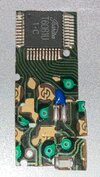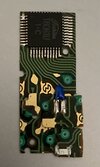I worked on making some 3.5 mm hand formed brass today to try and flesh out this concept from the ground up.
Using basic tools available to a shop-
1- Vintage vector board cutoff or one of my replica clamp cards.
1- sheet strip of 2" (1/64" or 0,42mm brass)
- a flat, sharp vise (or these 8" Irwin grips)
- Mill ******* File
- hobby knife
- hand shears for metal (smooth edge important)
- Flat faced hammer
- Calipers
- Sanding block

I'll try and re-create the process and update this at a later time with more pictures/ video.
Use calipers to initially scribe your fold and cut lines on the brass. In my case, I scribed a line at 3.5 mm and 7mm.
- define the fold line by scoring the 3.5 mm line a couple times with the hobby knife- which creates a straight and shallow valley.

- clamping the uncut material at the 3.5 line it can be folded by pushing it sharply on another hard surface.

- Once folded, hammer it down to the vise surface to flatten it to 90 degrees.
- Once the fold is sharp, you can re-scribe 3.5 mm with your calipers on both sides.
- Using the metal shears, you can trim off the excess- and separate the angle from the rest of the material.
If there is any rough edge, or the thickness still needs to be reduced, you can clamp the L material and file it to the size you're looking for.
Once complete, you'll be able to use a square surface to additionally (very lightly) hammer out any deformations. In my case I used my small machine square. I imagine a machinist/ jewelers vise would work much better for some of these processes.
Here is the result:



and, using the vintage vector card.. just to confirm that I hit the sizing I was looking for in my collage app.
Worth noting the overall box width/ seen above is subject to the idea the rails were already falling off/ reglued.
And I also just had an epiphany about the setup of plastruct I’ve been using…. I’ll have to make another set but it is the same materials.
Using basic tools available to a shop-
1- Vintage vector board cutoff or one of my replica clamp cards.
1- sheet strip of 2" (1/64" or 0,42mm brass)
- a flat, sharp vise (or these 8" Irwin grips)
- Mill ******* File
- hobby knife
- hand shears for metal (smooth edge important)
- Flat faced hammer
- Calipers
- Sanding block
I'll try and re-create the process and update this at a later time with more pictures/ video.
Use calipers to initially scribe your fold and cut lines on the brass. In my case, I scribed a line at 3.5 mm and 7mm.
- define the fold line by scoring the 3.5 mm line a couple times with the hobby knife- which creates a straight and shallow valley.
- clamping the uncut material at the 3.5 line it can be folded by pushing it sharply on another hard surface.
- Once folded, hammer it down to the vise surface to flatten it to 90 degrees.
- Once the fold is sharp, you can re-scribe 3.5 mm with your calipers on both sides.
- Using the metal shears, you can trim off the excess- and separate the angle from the rest of the material.
Once complete, you'll be able to use a square surface to additionally (very lightly) hammer out any deformations. In my case I used my small machine square. I imagine a machinist/ jewelers vise would work much better for some of these processes.
Here is the result:
and, using the vintage vector card.. just to confirm that I hit the sizing I was looking for in my collage app.
Worth noting the overall box width/ seen above is subject to the idea the rails were already falling off/ reglued.
And I also just had an epiphany about the setup of plastruct I’ve been using…. I’ll have to make another set but it is the same materials.
Last edited:


